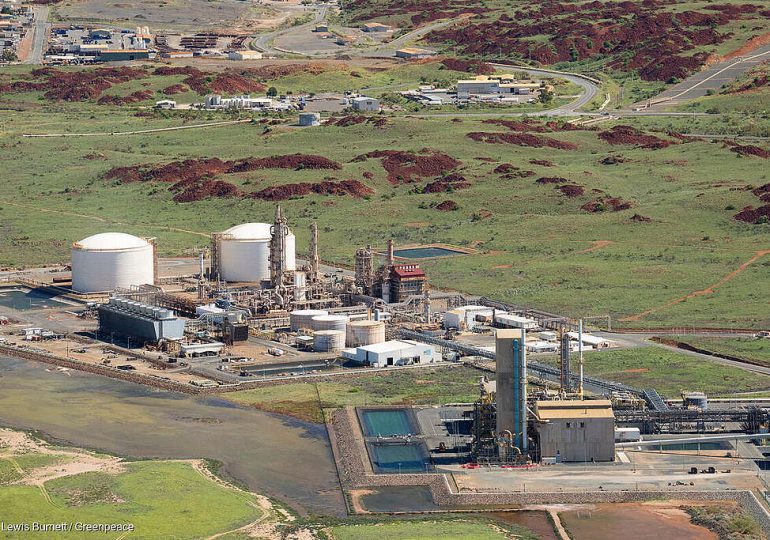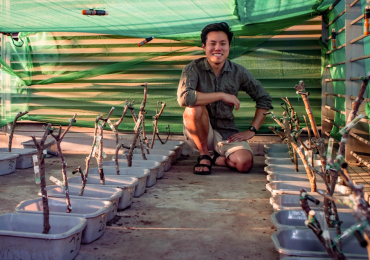WA is falling behind on pollution limits
Western Australia often likes to go its own way. Sadly, when it comes to carbon pollution WA has been stubbornly bucking the national trend – but not in a good way. While the rest of the country has been reducing emissions, WA’s have been rising, largely thanks to the gas industry.
It’s true that some things are a bit different in the West and the decarbonisation pathway for WA will have its own twists and turns. When it comes to electricity, WA will soon be the first state to fully exit from coal-fired power generation, but its reliance on another fossil fuel – gas, means it has had a remarkably slow build out of renewable energy.
Which means the transition is lagging behind.
WA currently uses as much gas as the rest of the Australian states combined. But most of it is not for households. It’s for electricity generation, industry, mining, and the biggest user of all is the gas export industry.
Aerial view of the Yara Pilbara operated liquid ammonia plant on the Burrup Peninsula. © Lewis Burnett / Greenpeace
Our report shows that WA can power its industry with clean energy – not gas.
We are all too familiar with the tired arguments of the gas industry who want to keep WA hooked on gas, who claim that even more is needed to keep WA running. Because of lobbying from Big Gas, WA has often argued that the state deserves special leeway in its emission reduction efforts due to its gas-reliant heavy industry.
Big Gas uses the same arguments to justify drilling for new gas – even where that will involve massive new emissions, and in the case of Woodside’s Browse project, drilling 50 gas wells around Scott Reef. They claim WA needs these new environmentally destructive projects to maintain our prosperity.
Well, now the evidence is in. We have run the numbers and modelled an achievable pathway that clearly shows that no new gas is needed in WA to keep our economy growing through the energy transition.
Our new report Power Shift: WA’s Electrified Future written in collaboration with Springmount Advisory, clearly demonstrates that rapid emissions reduction is not only possible in WA but is in the economic interests of the West Australian public.
The report breaks down the path Western Australia needs to take across its economy to drive down emissions in line with limiting warming to 1.5 degrees, and to become a renewable energy and green export powerhouse. It does so with a detailed breakdown of key timelines and dates for the phase out of fossil fuels that has not been seen before.
Banner reading “Protect Our Oceans” is displayed near a turtle during Greenpeace Rainbow Warrior’s documentation trip off Exmouth, Western Australia. © Harriet Spark / Grumpy Turtle
It is time for WA to choose its future
But key decisions will need to be made – to be clear, this is no small task.
WA currently lacks the sufficient supporting policies to encourage industry to decarbonise, attract investment and support workers through the transition. Australia needs WA to be leading the charge to a renewable energy future if we are to meet our national emissions reduction commitments and if we are to maintain our country’s economic status through exportable green commodities.
Some big mining operations are already making the move to renewables due to their cost effectiveness, but for many years Governments of all stripes have subsidised and incentivised fossil fuel use, meaning many industries are stuck with the status quo. Governments now have a role in creating a new set of policies which reward reducing pollution.
This report comprehensively breaks down the transition pathway WA can take to make that future possible. It covers energy, industry, transport and agriculture, highlighting the challenges and opportunities across each, and providing policy level solutions to achieve these ambitions.
A Greenpeace sign placed on a dead coral reef in Ningaloo Marine Park. © Lewis Burnett / Greenpeace
Key Findings
Critically, this modelling demonstrates that WA does not need any new gas to keep the lights on and grow the economy.
The modelling in this report demonstrates that:
There is a fast and achievable path for WA to move to clean energy, protecting our climate and nature, while keeping the lights on and growing the economy
WA can be the heart of a strong Australian renewable energy economy
WA doesn’t need more gas (including Woodside’s Browse gas field which lies directly under the pristine Scott Reef).
Send a message to WA’s Leaders
Please read the report, share it with your friends, your MP and sign our petition calling on Premier Roger Cook to put WA on a clean, fair and renewable path.
Leave a comment





